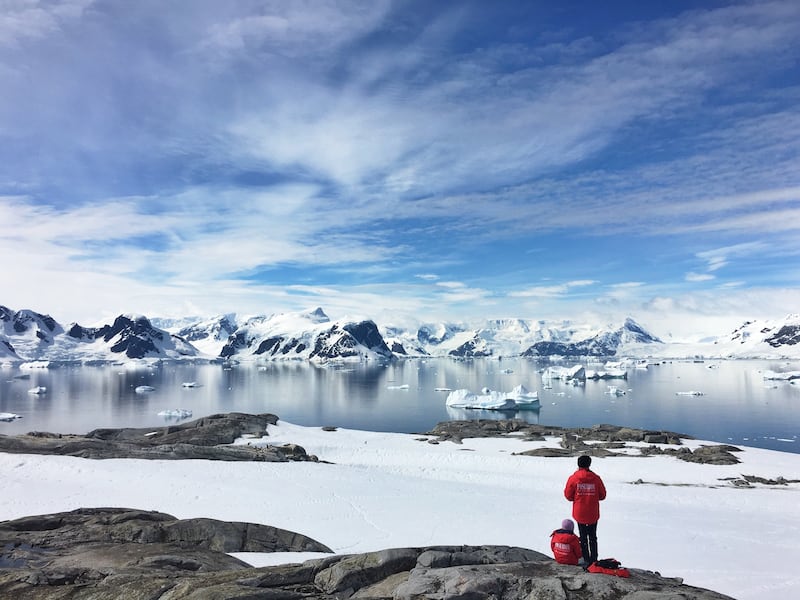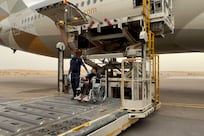Last year, for the first time, more than 100,000 tourists visited Antarctica. That figure is expected to increase in 2024.
It is in stark contrast to visitor numbers during the global pandemic when only two ships and 15 people ventured to the southern wilderness in the name of tourism.
Leslie Hsu, a freelance journalist and award-winning photographer, understands why. She had one of her most memorable holidays in the region.
She recounts a story of camping on the Kerr Point of Ronge Island, where she could hear the iceberg-laden waters of the Errera Channel lapping against the shore.
“I make my way towards the shoreline until I can hear waves striking rocks,” she tells The National. “Turning off my headlamp, I am engulfed in darkness, barely able to see my fingers in front of my face. At first, I feel exposed, vulnerable – unusual for someone who grew up camping, hiking, spelunking, climbing mountains and crossing rivers. Someone who came to Antarctica precisely to be alone with the coldest, driest, windiest, most hostile place on Earth.
“A series of glaciers calving, one after another like dominoes, ripples towards me. I feel the ground trembling. Water rushes towards me and I cringe, expecting to be swept away into the channel. After things settle down, I sit down on the soft snow. Surprisingly, I don’t feel cold at all, cosy in my wind and water-resistant parka and boots. I doze. I listen. I breathe. Out of the darkness, blacks brighten to greys. There is no sunrise, just a gradual increase in contrast.
“I hear a whale surface for air. Kelp gulls tweet a morning greeting. And just when I start to worry that maybe I shouldn't be sitting out here by myself, I see six Gentoo Penguins take form not a stone’s throw away. They are all sleeping with their necks tucked into their backs, perfectly camouflaged in the austere black and white landscape.”
It's precisely this type of once-in-a-lifetime experience that has so many travellers flocking to Antarctica.
Unique journeys across the White Continent
This polar region is roughly twice the size of Australia and 98 per cent covered in ice. It is the largest wilderness on Earth unaffected by large-scale human activities and, as the only continent without an indigenous population, it is also one of the most protected places on the planet.
Winter in Antarctica is from March until October, and when daylight hours disappear, temperatures plunge to minus 30-60°C and the physically remote destination becomes even more inhospitable. But by autumn, as the country’s unique wildlife begins to emerge from hibernation, so too do the zealous tourists.
Antarctica is also the only continent with no terrestrial mammals, but it does have millions of penguins, thousands of seals and eight different species of whale. The allure of seeing these creatures in the wild is one of the main reasons people keep coming to the remote land.
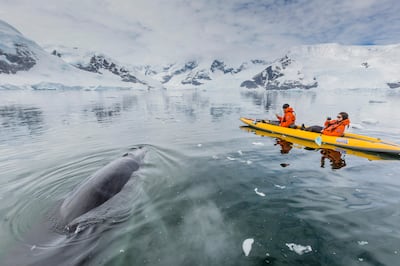
Google data comparing search traffic from 2019 to 2022 showed a 51 per cent rise in interest around Antarctica cruises, and a 47 per cent rise in interest for Arctic cruises. Other trips are on the rise, too. These include luxury travel company Black Tomato’s nine-night Antarctic adventure that sailed to the White Continent at the same time the region witnessed a rare solar phenomenon. Or Elite Expeditions' new voyage that will see travellers conquer the glacial beauty of Antarctica's Vinson Massif.
While the pause in tourism during the pandemic allowed wildlife to thrive, the International Association of Antarctica Tour Operators estimates that 106,000 visitors travelled to the region in the 2022-2023 tourist season, meaning those who work to protect the White Continent and its environment are wary of this increasing interest.
A wilderness that belongs to no nation
Seven countries – New Zealand, Australia, France, Norway, the UK, Chile, and Argentina – have all laid claim to different parts of Antarctica, but the destination is governed by an international partnership to which more than 56 countries have acceded, making it a wilderness that belongs to no nation.
Its tourism board is also unique. In 1991, the International Association of Antarctica Tour Operators (IAATO) was set up not to encourage more visitors, but to regulate the sector and ensure the pristine environment remains so. Since 2009, concerns about the impact of tourism on the environment have been a recurring hot topic at the continent’s annual Antarctic Treaty Consultative Meeting.
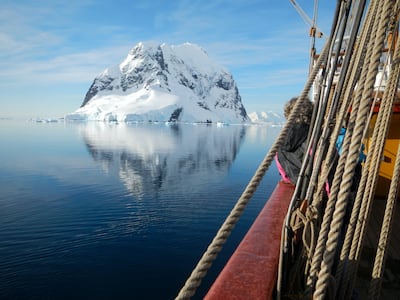
Several measures are already in place. As most visitors venture to the seventh continent via ship, better practices have been adopted to reduce the carbon footprint and environmental impact of any cruises sailing in these waters. There are also restrictions on how many people are allowed ashore, and strict regulations for planned activities, wildlife watching, and pre and post-visit activity reporting.
These rules are carefully followed by Black Tomato on all of its voyages. “We demand the highest standards from our partners, in everything from sustainability to safety, creativity to delivery,” says Tom Marchant, co-founder of the luxury tour operator. “In Antarctica, those standards mean we only work with a small selection of hand-picked IAATO-approved operators, and have seen us advocate light-touch, small-scale experiences where we can be assured that guidelines are being followed.”
In a post-pandemic world, the tourism company sees travellers seeking one-off adventures, something Antarctica is perfectly poised to offer. “A burgeoning trend we’ve seen since the pandemic is a strong pursuit of [what we call] the 'opposite', be it a safari, the wilderness, volcanic ranges or rugged islands – the flip side of big buildings and noisy cars in everyday life,” Marchant explains.
“Now, more than ever, travellers are seeking out the world untainted by crowds and queues. A world more ancient than our own, and with deeper roots. Antarctica is a great example of where dramatic and unfamiliar landscapes offer inimitable encounters that are all about experiencing the unknown. The opposite of our own daily lives.”
Will overtourism be Antarctica's downfall?
But as a destination that has long been sheltered from mass tourism, could this recent spike in traveller interest be the continent’s downfall? Could Antarctica be on track to become overtourism’s next victim, going the way of Mount Everest, with overcrowding and environmental pollution? Or of Italy’s Venice, which constantly struggles with the impact of visitors flocking in from visiting ships?
The IAATO says it is unlikely this will happen, saying the region's strict protection protocols are its saving grace.
“Antarctica is one of the most protected locations – if not the most protected location – on Earth when it comes to managing human activity,” a representative for the organisation tells The National. “All human activity there must be authorised by a competent authority and is subject to an Environmental Impact Assessment before proceeding.
“There is still a misconception that visitors to Antarctica are permitted to explore as they like, picking up souvenirs from the coastline and disturbing wildlife. IAATO’s rigorous rules and guidelines explained and enforced by expert field staff, coupled with robust policies laid out by the Antarctic Treaty, ensures this is not the case.”
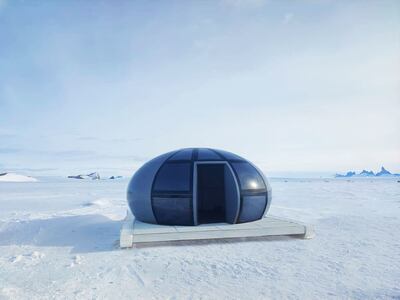
White Desert, an ultra-luxury travel operator that specialises in zero-impact trips to Antarctica, has been a member of IAATO for nearly two decades. “We take just 250 people yearly – a maximum of 12 guests per trip travel to our camps during season, which runs from mid-November until February,” says chief executive and founder Patrick Woodhead.
“We have five key steps in place to minimise our impact, including using sustainable aviation fuel, carbon offsetting, an environmentally conscious supply chain that ensures we use no single-use plastic and responsibility for waste disposal. We also use solar energy to heat our pods and minimise use of fossil fuels. And we support and contribute to both the local scientific community and the Antarctic community.”
It's common for Antarctica operators to use tourism dollars to help fund scientific research that can help the world better understand the White Continent. Viking Cruises, for example, uses both of its Antarctic ships to host scientists, wet labs and detailed research programmes, all funded by holidaymaker’s money. And Ponant uses tourism revenue to offer science expedition grants for studies in the region.
IAATO says contributions like these are “fundamental to achieving research objectives in different fields of knowledge, going from the understanding of polar tourists’ behaviour and learning to the evaluation of environmental changes in places threatened by global warming”.
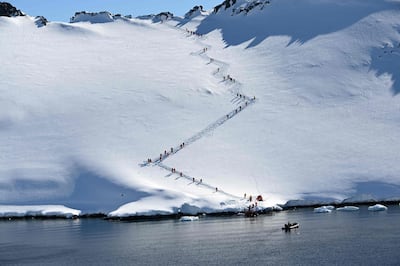
But for the conservation-focused Antarctic and Southern Ocean Coalition, the measures adopted by tour operators may not be enough.
“In the absence of a comprehensive plan for managing tourism and tourist activities, adding new trips, inland activities and off-the-beaten-path excursions in Antarctica is a risky trend,” says the NGO's executive director Claire Christian.
“Ideally, any expansion in the areas that tourists visit or diversification of activities that tourists participate in should only take place as part of a management plan that has fully considered whether these activities are consistent with the environmental protection goals of the Environment Protocol. However, right now, there is no such plan.”
A delicate balance
While the majority of people visiting the region do so on vessels and never step foot on the ice, as more travel companies go out of their way to offer unique journeys that take travellers on land, the risk to the destination increases.
No matter how regulated the industry is, if the tourists snowshoeing through Antarctica’s ice-covered wilderness don’t adhere to the same ethos, damage could be inevitable.
To pre-empt this, IAATO publishes a series of general guidelines that visitors are expected to follow. These include everything from not touching wildlife to responsibly discarding rubbish and being aware of protected areas. However, membership to the association is not compulsory and if there are 106,000 visitors heading to Antarctica in a single season, how realistic is it that every tourist’s actions can be controlled?
Hsu questioned this on her dream trip to Antarctica last year. “Hurginten Expeditions was very careful about marking all the places that travellers were allowed to hike with cones whenever we left the ship, but even though they marked it off, it wasn’t always 100 per cent clear what areas we were supposed to stay away from,” she explains.
“I did wonder if all of these people walking around were affecting the landscape. We also saw many empty research stations as we ventured across the continent and this made me wonder whether these abandoned buildings are environmentally safe.”
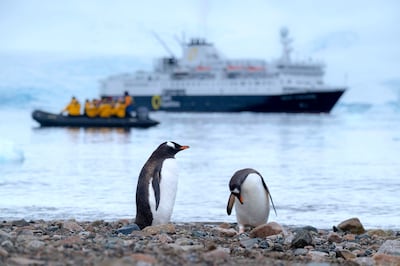
Some tour operators, including White Desert, believe that by offering these life-changing expeditions, they will help “create a community of Antarctic Ambassadors who will share the importance of conserving the planet for future generations”.
Hsu is a living example of this. “The first thing I did when I got home was Google 'Antarctica Ambassadors' to find out more about this collaboration of people who care passionately about Antarctica and protecting its unique landscape. I had never heard of it before and I immediately signed up.”
Despite these initiatives, a question mark hangs over how Antarctica may fare as tourism continues to rise, especially as the Antarctic treaty that preserves the continent will only remain in place until 2048. After that, any treaty party can request a review, which could lead to crucial elements being changed.
“The treaty is up for renewal in 25 years and it’s vital that it’s upheld,” says White Desert founder Woodhead. “The protocol contains a number of tools, including environmental impact assessments and protected areas, that are extremely effective. Parties simply must use them, and it is critical for Antarctica's future.”
It may not yet be on course to rival Mount Everest as one of tourism's nature playgrounds, but as of now the balance of travel and preservation in the world’s most remote wilderness remains as fragile as the ice-covered sheets that surround it.
